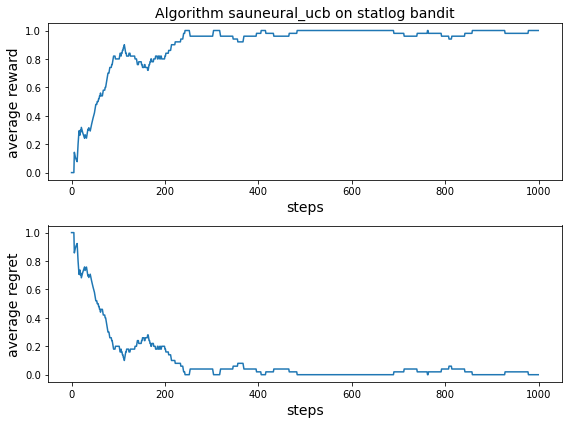This is the project site for the paper
Rong Zhu and Mattia Rigotti, "Deep Bandits Show-Off: Simple and Efficient Exploration with Deep Networks", in Advances in Neural Information Processing Systems 34 (NeurIPS), Dec. 2021 [arXiv:2105.04683]
We introduce SAU-exploration, an exploration method for the bandit framework with strong theoretical guarantees in the Multi-Armed Bandit setting and very efficient implementation in the contextual bandit setting.
In combination with a deep neural networks, SAU-exploration gives rise to a very simple and efficient deep contextual bandit algorithm that achieves higher rewards than state-of-the-art Bayesian algorithms like Neural Linear (a neural network with an exact linear posterior classifier introduced by [Riquelme et al., ICLR, 2018]), but is as fast as a neural network with -greedy exploration.
- Python 3.6 or above
- PyTorch 1.6.0
- Numpy 1.19.1
- SciPy 1.5.2
- Matplotlib 3.3.4
These can be installed using pip by running:
>> pip install -r requirements.txtLet's look at a basic example of how to use the code (which you can execute with the jupyter notebook run_basic_example.ipynb in the repository. In this example we will use SAU-Neural-UCB (SAU-UCB combined with at Neural Network) to tackle the the Statlog bandit problem, a contextual bandit problem based on the Shuttle Statlog Dataset in the UCI machine learning repository:
BANDIT_NAME = "statlog"
AGENT_NAME = "sauneural_ucb"
TIME_STEPS = 1000Let us import the functions to load pre-implemented contextual bandit problems and agents (learning algorithms), and the Deep Contextual Bandit Trainer (which includes the architecture):
from run_bandit_experiment import load_agent, load_bandit
from lgenrl import DCBTrainerLet us now load the Statlog bandit (which will also download the dataset is it's not already present in the folder ~/data/statlog), load the SAU-Neural-UCB exploration algorithm, instantiated a trainer and use it to deploy the exploration algorithm:
bandit = load_bandit(BANDIT_NAME, download=True)
agent = load_agent(BANDIT_NAME, AGENT_NAME)
trainer = DCBTrainer(agent, bandit, logdir="./logs/example")
results = trainer.train(
timesteps=TIME_STEPS, batch_size=64, update_after=20, update_interval=20, train_epochs=10
)Started at 25-10-21 14:50:48
Training SAUNeuralAgent on StatlogDataBandit for 1000 timesteps
timestep regret reward cumulative_regret cumulative_reward regret_moving_avg reward_moving_avg
100 0 1 39 61 0.2 0.8
200 0 1 60 140 0.2 0.8
300 0 1 62 238 0.04 0.96
400 0 1 66 334 0.02 0.98
500 0 1 68 432 0.0 1.0
600 0 1 68 532 0.0 1.0
700 0 1 69 631 0.02 0.98
800 0 1 72 728 0.04 0.96
900 0 1 73 827 0.0 1.0
1000 0 1 74 926 0.0 1.0
Training completed in 0 seconds
Final Regret Moving Average: 0.0 | Final Reward Moving Average: 1.0
Let us now finally look at the results by plotting the average reward (averaged over a moving window of 10 time steps) as a function of time step, and at the average regret:
import matplotlib.pyplot as plt
plt.subplot(2,1,1)
plt.title(f"Algorithm {AGENT_NAME} on {BANDIT_NAME} bandit", fontsize=14)
plt.plot(results['reward_moving_avgs'])
plt.ylabel('average reward', fontsize=14)
plt.xlabel('steps', fontsize=14)
plt.subplot(2,1,2)
plt.plot(results['regret_moving_avgs'])
plt.ylabel('average regret', fontsize=14)
plt.xlabel('steps', fontsize=14)
plt.tight_layout()
plt.show()The script run_bandit_experiment.py reproduces the main deep contextual bandit results of the paper:
>> python run_bandit_experiment.py --helpUsage: run_bandit_experiment.py [-h] [--agent AGENT] [--bandit BANDIT]
[--delta DELTA] [--run RUN]
[--experiment EXPERIMENT] [--use_cuda]
[--download]
Deep Contextual Bandit Experiments
optional arguments:
-h, --help show this help message and exit
--agent AGENT name of bandit algorithm (options: linear|neurallinear
|lineargreedy|neuralgreedy|saulinear_sampling|saulinea
r_ucb|sauneural_sampling|sauneural_ucb|uniform)
--bandit BANDIT name of bandit dataset (options: mushroom|statlog|cove
rtype|adult|financial|jester|census|wheel)
--delta DELTA delta parameter of the wheel bandit between 0.0 and
1.0 (it is ignored if bandit is not wheel)
--run RUN run number
--experiment EXPERIMENT
tells program to run an experiment (starts from 1,
corresponding to a combination of bandit x agent x
run)
--use_cuda enables CUDA training
--download download datasets if missing
